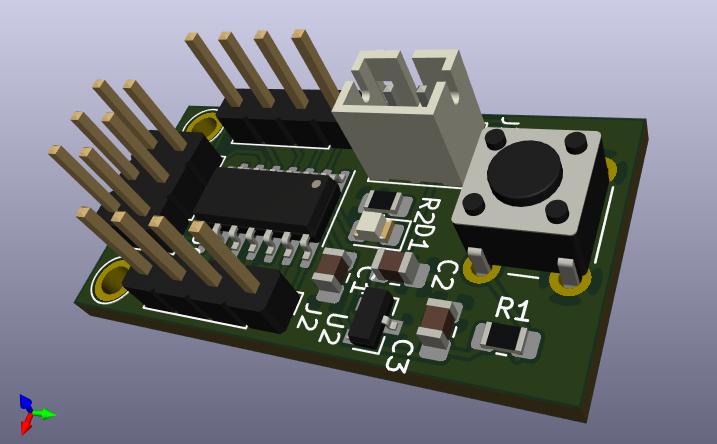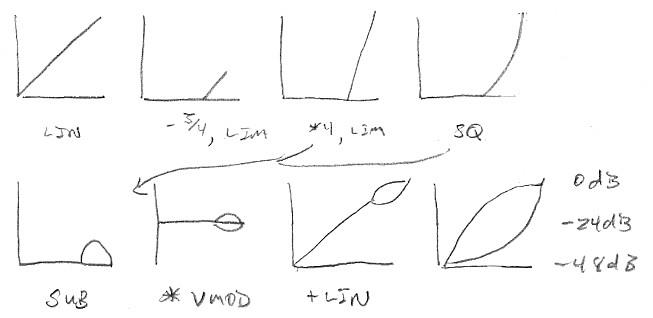Simple evocation of an abstract concept can put a song in my head for weeks. Why did I ignore the warning ?
Fly me to the moon...
Nice rendition anyway
KiCad
Yesterday I did the nice little tutorial here: https://github.com/MalphasWats/hawk
This morning I noticed there's a built-in 3D viewer:

Can't say I'm anywhere near "pro" level yet, but my feet are wet!
"3d viewer in KiCAD is useful feature - for checking of component placement and silkscreen layer text." - Buggins
Yes, it's pretty fantastic as a check! I was squinting at the Gerber files trying to verify stuff, particularly holes and the solder masks, but this shows everything all at once.
"Does any other instrument have this section in its manual? E.g. how to play the tuba? Do tubas even come with manuals?
To me, the theremin is very different as there are no “correct” fingerings or other considerations found on other instruments. Some, like Carolina Eyck have developed their own approaches, which work very well for them but those aren’t necessarily the only or “best” ways. (BTW, I think Carolina Eyck is a BRILLIANT musician - I’m not disparaging her in any way.) To me, the theremin seems to be more related to singing (I’m not a singer) than being an instrumentalist, although instrumentals - such as Leon Theremin and Clara Rockmore - were clearly responsible for the development of the instrument. One does not need instructions or lessons to sing; the same is true for the theremin. HOWEVER (that’s a BIG “however”), I think singing for pleasure is easier because we don’t really have to think much about technique (the mechanics of singing or playing and instrument), whereas we not only have to use our ears (which everyone who makes music must do) but also need to deal with complex gross and fine motor skills that use both hands (especially difficult for adults who have not done so previously. As a bassoonist who never played the piano (a keyboard instrument that requires both hands to work independently from one another), I could practice until the cows come home and I’ll never be able to play the solo part of a Rachmaninov Piano Concerto.
The theremin is also different than pitched instruments - woodwinds generally have one fingering (or in the case of the bassoon, MANY different fingerings) for the each note, brass instruments have specific fingerings (or positions as in the case if the trombone) for specific notes that can only be produced with the correct embouchure (correct use of mouth/lip muscles), and string instruments without frets have specific positions on their fingerboards. All of these specific fingerings or positions produce a relatively close approximation of the correct note, which must then be tempered by the individual musician based on acquired additional skills, study, and ear training.
Fixed-pitched instruments, such as keyboards, fretted strings, pitched percussion (xylophones, marimbas, etc), etc. simply produce the correct pitch by playing the instrument. A rank beginner on the piano may sound awful but will never be out of tune as long as the correct key is struck at the correct time.
The theremin, on the other hand, can’t be played in tune, or even roughly in tune, with the same ease as other instruments. It absolutely requires extensive use of the ear AND the development of motor skills - all of which are dependent upon many factors dictated by the individual instrument, the weather, probably planetary alignment (just kidding - LOL), etc.! Pitch correction may serve as a crutch to help with that but it’s only a crutch which, more than likely, inhibits the development of good skills. Despite my own very limited experience with the theremin, I have heard experts strong discourage others from using pitch corrections (or even preset scales on the Theremini). I will confess that when I have tried preset scales on the Theremini, they’re fun but I NEVER use them for genuine practice.
Regarding pitch preview, I haven’t yet seen it in use but I will say that for the vast majority of the world (myself included) who were not born with perfect pitch, it may be very helpful to find the starting note of a melody. I wonder how it is used, if at all, later in a piece when there’s an extended rest before the melody starts up again - this occurs a LOT in classical music. At the moment, when I’m practicing, I try to play to beginning note very softly (if there’s an introduction to the piece) and or glance at a tuner that I have connected directly to my instrument (the tuner will provide my with the exact note, and indicate if it’s in tune, if I keep my left hand volume down. Such a feature, for me, would be very useful.
Anyway, I’ve rambled on far too long! Other than instructions on the settings and there uses, along with some rudimentary information on playing the theremin (such as, the vertical antenna controls pitch and the left hand controls volume, etc.) I think “Playing the Theremin” section should be kept to a minimum. A resource section, such as contact information for Theremin World and other sources would be useful. Similarly, a bibliography for good information would be great.
"The theremin, on the other hand, can’t be played in tune, or even roughly in tune, with the same ease as other instruments. It absolutely requires extensive use of the ear AND the development of motor skills - all of which are dependent upon many factors dictated by the individual instrument, the weather, probably planetary alignment (just kidding - LOL), etc.! Pitch correction may serve as a crutch to help with that but it’s only a crutch which, more than likely, inhibits the development of good skills. Despite my own very limited experience with the theremin, I have heard experts strong discourage others from using pitch corrections (or even preset scales on the Theremini). I will confess that when I have tried preset scales on the Theremini, they’re fun but I NEVER use them for genuine practice." - ContraDude
IMO, Theremini pitch quantization is more for playing arpeggios in space, and not so much an aid to playing in tune. It makes for impressive demos in the store and to your friends, but nothing a player would routinely engage for even slightly serious melodic pieces. The addition of a low pass filter could have turned it into genuine pitch correction (but the general sluggishness would need to be addressed too).
Real-time pitch correction suffers from the same issue that tuners do, which is the lack of immediately accurate pitch data. The time it takes to determine the pitch from a waveform to a sufficient degree to be useful is often just too long to tightly integrate anything that depends on it into feedback for one's playing technique (whether doing so is a crutch or not is a separate subject).
Real-time pitch correction requires the player to have some immediate reference to absolute pitch, which a real-time tuner is in an excellent position to provide. My playing "technique" (if it can be called that) is highly dependent on both (for better or worse time may tell). Without them I don't know if I could stand to hear myself practice (but without them I would perhaps be relying on other means of feedback, who knows).
Very nice chatting with you today!
Dewster - "Very nice chatting with you today!”
Thanks! I really enjoyed our chat too! The D-Lev appears to be a fantastic instrument!!
Dropping Drop
Roger pointed out the lameness of the noise level volume modulation, a knob labeled drop. It introduces extra downward linear slope to the noise level above the knee, and it leaves much to be desired in operation. I replaced it with the same vmod used for pitch preview, but this too was found to be wanting. With a bit of thought I came up with this approach:

We take the linear volume hand data, subtract 3/4 from it and chop off the negative, multiply it up by 4, square it, and then subtract the two last results to get a bump. This bump is multiplied by the vmod knob value, and the result is added to the linear hand data to control the noise level. It operates from -48dB to 0dB, and extreme positive settings of the vmod knob give a peak around -24dB with roll off to either side. Extreme negative settings of vmod give a quick ramp up to 0dB.
This feels like an improvement, and I very much appreciate Roger's keen ear and escalation of the issue.
[EDIT] Speaking of second harmonics (and then some!): [MP3].
Second SPDIF DAC BoxBought a second DAC box off Amazon back in October for $10 USD: https://www.amazon.com/Digital-Converter-Tackston-Optical-Toslink/dp/B086SC4C1LWorks fine, L&R may be swapped IIRC, haven't tried the headphone out or the SPDIF in. Thought I'd open it up today and check out the guts:Advanced Monolithic 3.3V LDO regulator, unmarked op-amp, NS6000 main IC that I can't find any specs for - I can't even identify the logo:https://how-to.fandom.com/wiki/How_to_identify_integrated_circuit_(chip)_manufacturers_by_their_logos/A-E
You must be logged in to post a reply. Please log in or register for a new account.